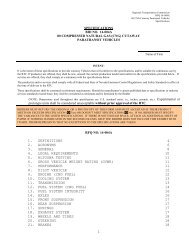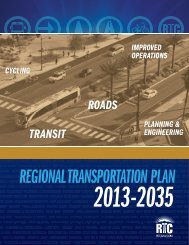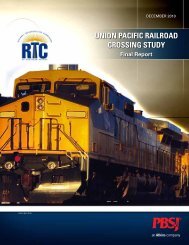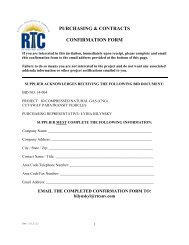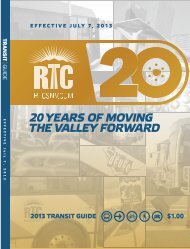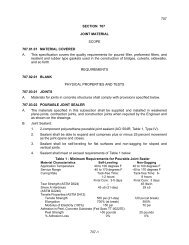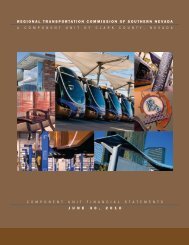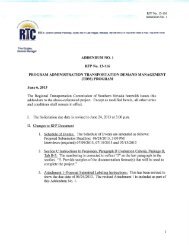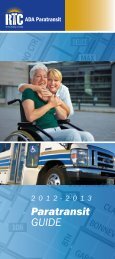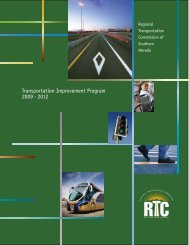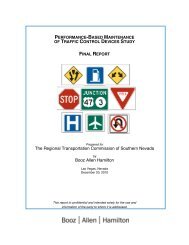(Blue Diamond Road) Corridor Study - Regional Transportation ...
(Blue Diamond Road) Corridor Study - Regional Transportation ...
(Blue Diamond Road) Corridor Study - Regional Transportation ...
You also want an ePaper? Increase the reach of your titles
YUMPU automatically turns print PDFs into web optimized ePapers that Google loves.
8. Estimated System Costs RTC SR-160 <strong>Corridor</strong> <strong>Study</strong><br />
8.2 OPERATING COST ESTIMATES<br />
Annual operating costs of transit alternatives in the corridor must also be considered when<br />
selecting a transit investment. Operating costs represent an ongoing, recurring expense<br />
that can quickly dwarf the start up capital investment of bus alternatives, and must be<br />
accommodated within RTC’s annual transit operating budget.<br />
8.2.1 Estimation Methodology<br />
Two primary sources of information were used in the development of operating cost<br />
estimates for transit alternatives in the SR-160 corridor – the Federal Transit Administration<br />
(FTA) evaluation of the Las Vegas Metropolitan Area Express (MAX) and performance trend<br />
data for CAT route 113 and MAX from RTC’s transit department. Hourly marginal operating<br />
cost estimates from these two sources have been inflated to current year dollars and are<br />
applied to annual revenue service hour estimates for each of the alternative bus routes<br />
making up Alternatives 1 and 2 for the SR-160 corridor. Hourly operating cost estimates<br />
incorporate the contractor hourly rate plus a variable cost per hour for RTC transit division<br />
staff, and are shown in EXHIBIT 8-4.<br />
EXHIBIT 8-4: Hourly Marginal Costs for CAT Services<br />
Service Type 2004 2006 estimated<br />
CAT Bus Route $52.52 $55.72<br />
MAX $78.38 $83.15<br />
Note: Costs reflect hourly contractor costs plus RTC variable costs per<br />
hour as identified in performance trend data for route 113 and MAX<br />
provided by RTC’s transit department. Costs have been escalated by<br />
3% per year to arrive at estimated current year (2006) costs.<br />
For each of the transit alternatives under consideration, annual revenue service hours were<br />
estimated using some basic assumptions:<br />
Peak frequency based on that of the current CAT route to which the proposed bus<br />
alternative would connect;<br />
Off-peak frequency estimated at half the peak period frequency or 60 minutes,<br />
whichever is less;<br />
Both peak and off-peak periods last twelve hours;<br />
Weekdays – 254 in total – use the 12/12 peak/off-peak split while<br />
weekends/holidays – 111 in total – are treated as 24 hours of off-peak operations;<br />
Operating speeds for local, express, and BRT alternatives are 10 mph, 13 mph, and<br />
16 mph respectively (based, in part, on data provided in the FTA review of MAX).<br />
8-7



